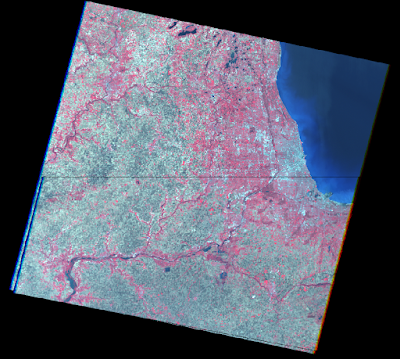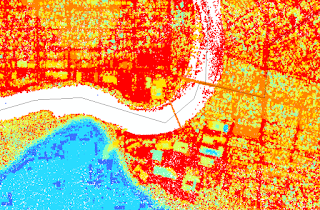The main goal of this lab is to gain experience in measuring and interpreting spectral reflectance (signatures) of various materials and Earth surface features captured by satellite images. After collecting spectral signatures from remotely sensed images, they will be graphed and analyzed. Another goal of this lab is to monitor the health of vegetation and soils using simple band ratio techniques.
Methods:
Part 1: Spectral signature analysis
Using a Landsat ETM + image that covers the Eau Claire area and other regions of Wisconsin and Minnesota, spectral signatures were collected of the following various Earth surface and near surface features:4.
1.Standing Water
2.Moving water
3.Deciduous forest.
4.Evergreen forest.
5.Riparian vegetation.
6.Crops
7.Dry soil (uncultivated)
8.Moist soil (uncultivated)
9.Rock
10.Asphalt highway
11.Airport runway
12.Concrete surface (bridge, parking lot, or any type of concrete surface)
These were then all put onto signature mean plot charts in order to compare the reflectance from different bands. These results can be seen in Figures 3, 4, and 5.
Part 2: Resource monitoring
Section 1: Vegetation health monitoring
By implementing the normalized difference vegetation index (NDVI) on an image of Eau Claire and Chippewa counties, a simple band ratio was performed. Figure 1 shows the ratio used for this section. A map was then created in ArcMap to show the abundance of vegetation present in the counties (Figure 6).
 |
| Figure 1 |
Section 2: Soil health monitoring
By implementing the ferrous mineral ratio on the same image from Section 1, a simple band ratio was performed. Figure 2 shows the ratio used for this section. A map was then created in ArcMap to show the spatial distribution of ferrous minerals in the counties (Figure 7).
 |
| Figure 2 |
Results:
Part 1: Spectral signature analysis
 |
| Figure 3: The first spectral signature is plotted. |
 |
| Figure 4: This plot chart shows the differences in reflectance for bands 1-6 for dry and moist soils. |
 |
| Figure 5: This plot chart shows all the spectral signatures collected in one window. |
Part 2: Resource monitoring
 |
| Figure 6: This map shows the result of the NDVI implemented to show vegetation abundance in the counties. |
 |
| Figure 7: This map shows the result of the ferrous mineral ratio implemented to show the spatial distribution in the counties. |
Sources:
Satellite image is from Earth Resources Observation and Science Center, United States Geological Survey.
















